While it’s obvious that many different ball pythons look very different, not many people know that that’s because ball pythons have things called “morphs” that cause these differences.
What exactly are ball python morphs?
A morph is a genetic mutation that works to alter the physical appearance of a ball python while remaining the same breed. There are currently about 26 primary ball python morphs that change the physical appearance and price of those ball pythons drastically.
While we’ve listed 26 primary morphs in this post, there may be more than this. There is no universally agreed-upon number of primary morphs that exist.
Table of Contents
What Is A Ball Python Morph?
A morph is still a ball python, but it’s a different color and style than the ball python that you’ll commonly see. Morphism is different from birth defects, though, which is commonly a confusing concept for some people.
Common defects in snakes will be covered later in this post to help you better understand what differentiates these two things.
The exact reason why morphs exist in the first place is quite detailed and scientific, so it won’t be covered extensively in this post. However, the basic idea comes down to mutations. Every living thing is made up of DNA, which is a molecule that carries the instructions for growth and development in that living being.
A mutation in a DNA sequence results in quite a few different things happening depending on what DNA sequence mutated. Some mutations cause protein to be made, others prevent the production of protein.
The mutations that affect the physical appearance of snakes alter where and what kind of skin pigment is produced. This is the basic formulation of a morph.
When these mutations are present in the sex cells (sperm and eggs) of the parents, they can be passed on to their children and continue to be passed down for generations.
The dominance of these mutations determines whether or not they will actually be present in the children, and this dominance is a huge focus for snake breeders.
So, ball python morphs aren’t genetically-inferior creatures that lack certain features. Instead, they have everything that a normal ball python has, just presented in a different way!
What Are The Different Ball Python Morphs?
There are currently about 26 primary ball python morphs. This number doesn’t include the thousands of subspecies of morphs. All of those morphs are simply a combination of any of these 26 original morphs you will see below.
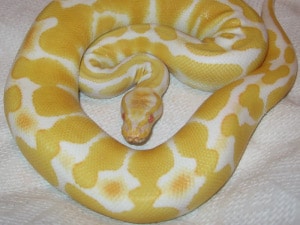

Albino Ball Python
This is the first proven recessive ball python mutation. Although it’s albino, this python has a yellow pigment along with its white scales and classic pink eyes.
Price
$300 – $400
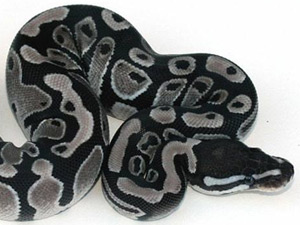

Axanthic Ball Python
Featuring a recessive mutation, these pythons have their red and yellow pigments suppressed, producing snakes that are gray, white, black, and brown. As they age, they become more brown.
Price
$375
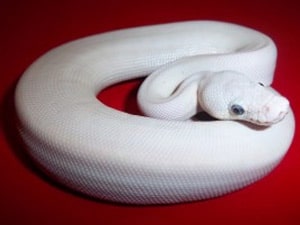

Blue-Eyed Leucistic Ball Python
A very rare morph that’s highly desired by snake enthusiasts. It’s classified by its blue eyes and pure white scales, and they are created by breeding Mojave, Butter, or Lesser ball pythons together.
Price
$400 – $600
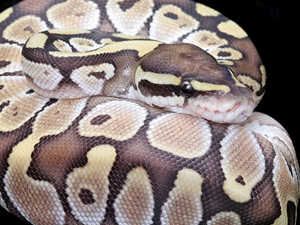

Butter Ball Python
Although these pythons appear similar to the lesser ball python, they’re entirely different. They share genes from the Lesser, Mojave, Phantom, and Russo and get brighter in color as they age.
Price
$100
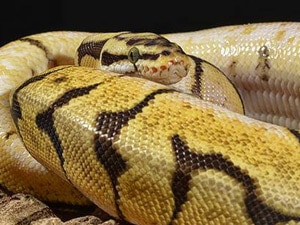

Bumblebee Ball Python
An aptly-named morph that features bright yellow and black scaled. They can’t be found in the wild, and are only created when a Spider and Pastel ball python are bred.
Price
$175
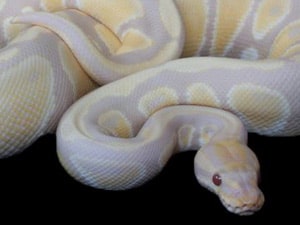

Candino Ball Python
This morph is very similar to the Albino ball python but features gray scales instead of white. Candino is a recessive mutation but will always yield more Candinos when bred with an Albino.
Price
$400
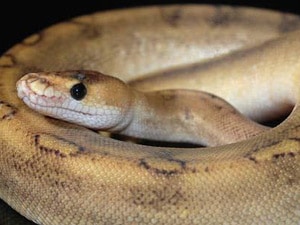

Champagne Ball Python
A light tan and orange snake, this python features dorsal stripes and circles that are irregular in shape. It also has an all-white belly and is a co-dominant morph.
Price
$250
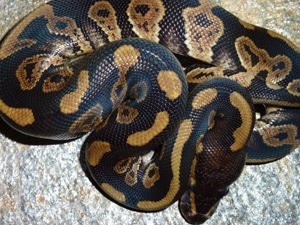

Chocolate Ball Python
Chocolate ball pythons are sometimes a bit tough to identify, but are most noticeably defined by their distinctive sheen, granite patterning, and an overall darker coloring.
Price
$100
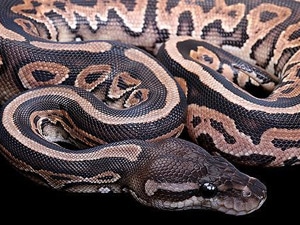

Cinnamon Ball Python
A dark brown snake with darker marking around its body. The color represents cinnamon, hence its name. The cinnamon gene is also co-dominant, resulting in quite a few blended pythons.
Price
$75
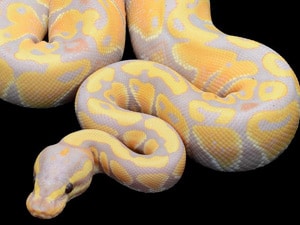

Coral Glow Ball Python
Coral Glow is a co-dominant gene with remarkable purple and orange colors being featured on their scales. Some Coral Glows only go on to produce males; no females.
Price
$350


Fire Ball Python
Another co-dominant gene that is often used to create a Super Fire ball python (Black-Eyed Leucistic). These are lighter in color than standard ball pythons and feature different markings.
Price
$400
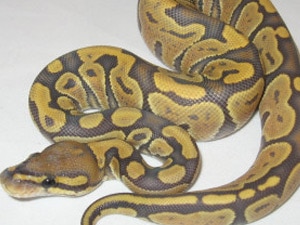

Ghost Ball Python
These pythons get the name Ghost due to the fact that their mutation reduces their black pigmentation. This results in their colors appearing hazy or muted.
Price
$75 – $100
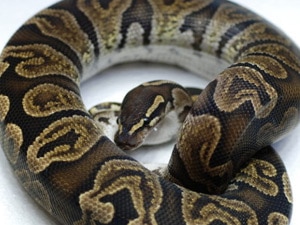

GHI Ball Python
GHI comes from the phrase “Gotta Have It”, as this is a morph that’s desired by snake keepers. It’s extremely dark and brightens as it ages, and it’s one of the most recently-discovered morphs.
Price
$500 – $3000+
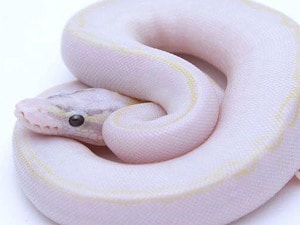

Ivory Ball Python
Ivories (also known as Super Yellow Bellies) are produced by mating two Yellow Bellies together, resulting in a Leucistic-looking morph that has more of a yellow hue.
Price
$300
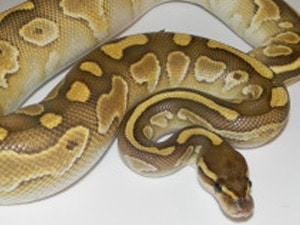

Lesser Ball Python
A beautiful morph that breeders often use to create other morphs. It has the common ball python pattern, but with more brown and yellow. It enhances the colors in the morphs is makes.
Price
$75 – $100
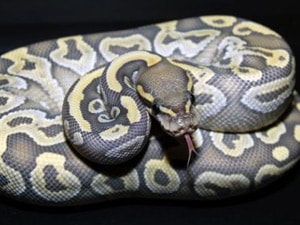

Mojave Ball Python
The Mojave pattern of this morph is appreciated by many. In addition to the unique design it features, its underside is completely white and it’s used to create Blue-Eyed Leucistic.
Price
$125
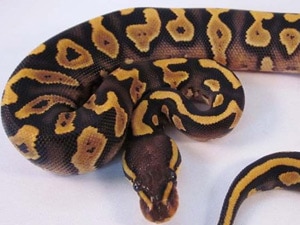

Mystic Ball Python
The Mystic morph appears similar to the Mojave, but with overall darker colors. Breeders commonly combine this morph with Phantoms or Mojaves to create a morph with pink, gray, and purple scales.
Price
$150
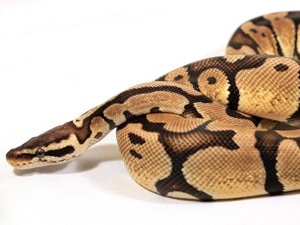

Pastel Ball Python
This is one of the most popular morphs available today. This snake is used to breed with other morphs to help amplify the intensity of the yellow pigmentation in the offspring.
Price
$75 – $150
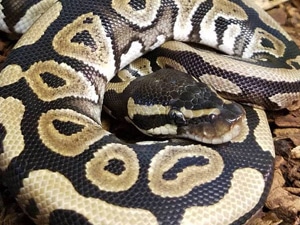

Phantom Ball Python
Phantoms are morphs that are used to create other incredible morphs. While Phantoms themselves aren’t crazy-looking, they produce Blue-Eyed Leucistics and Purple Passions.
Price
$125 – $150
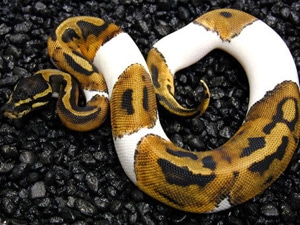

Piebald Ball Python
A strongly-desired morph by snake keepers due to its unique markings and colors. The Piebald recessive trait results in random patches of white and different colored patterns over their bodies.
Price
$300 – $550
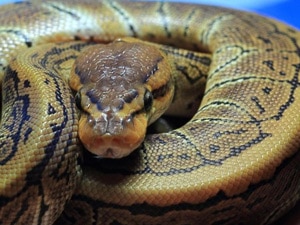

Pinstripe Ball Python
Featuring thin stripes along its backside, the Pinstripe morph has a deep caramel brown as a base color and breeds excellently with a variety of different morphs.
Price
$75 – $100
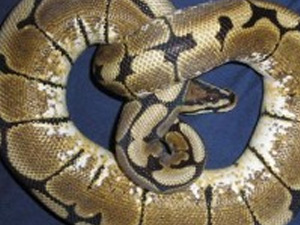

Spider Ball Python
This morph is light brown, black, and white and is commonly used for breeding due to its eye-catching pattern on its back and its white-colored underside.
Price
$75
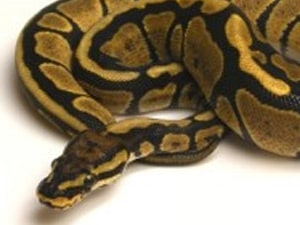

Spotnose Ball Python
Spotnoses are similar to other morphs but have a few differences. Of course there are spots present on their nose, but they also have a faded pattern on their head and a lighter dorsal.
Price
$125 – $175
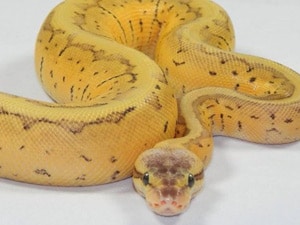

Super Blast Ball Python
A very distinct morph that snake keepers love. It features a bright yellow color with a light lavender-colored head. It’s created by breeding Pinstripes and Pastels.
Price
$225 – $325
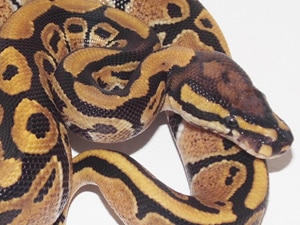

Vanilla Ball Python
Another normal-looking morph with two distinct differences. First of all, the vanilla color is brighter than standard ball pythons. Additionally, the top of this morph’s head is faded in color.
Price
$175 – $400
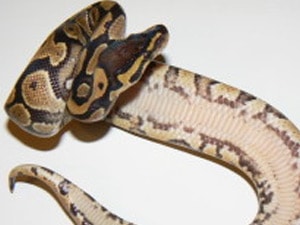

Yellow Belly Ball Python
One more average-looking ball python who’s only differentiation is its yellow underside. It’s a morph that’s most commonly used to create the Ivory ball python.
Price
$150
Ball Python Morph History
Ball pythons are not creatures that have been owned for a very long time. In fact, around the year 1990, ball pythons were barely wanted despite their excellent size, temperament, and appearance.
They were commonly kept, but snake keepers would always look to other kinds of snakes that were more physically-appealing, unique, and classy.
From 1989-1991, “attractive” ball pythons of all colors and patterns were purchased from importers for a slightly higher price. However, 1992 saw the first ever captive-bred albino ball pythons being sold for a whopping $7,500 each, sparking a massive interest in the overall business of ball python breeding.
After that point, imported ball pythons became much more closely-observed and analyzed to see if they’re different enough to hold any substantial value.
This in-depth studying of these snakes continues today, where breeders are now aware of the fact that morphs can be created through careful selective-breeding and aren’t just random genetic flukes.
This massive shift towards ball python breeding has made this one of the most popular snakes among casual owners, breeders, and collectors alike. With all of the different morphs available, the diversity present in ball pythons could allow them to remain a favorite for many years to come.
Most Desired Ball Python Morphs
While all of the ball python morphs that exist have interesting characteristics that could be appealing to a wide variety of people, there are definitely favorite morphs that emerge. These morphs are desired more than other morphs due to their individual characteristics that set them far apart from the other morphs.
- Albino Ball Python – The morph that arguably started the ball python morph craze. This morph naturally occurs through the breeding of two normal ball pythons, although that occurrence is quite rare. When it comes to breeding, having an albino as the parent is the best way to come about another albino. Their light color, pink eyes, and overall difficulty to breed make them a very highly-desired morph that generally fetches a very high price.
- Blue-Eyed Leucistic Ball Python – Easily one of the most unique and stunning morphs that exists. The striking white scales and blue eyes of this morph helps it stand out from all other ball python morphs that exist. To breed BEL ball pythons, you’ll need to combine a Lesser and Mojave, a Mojave and Phantom, or a Phantom and a Lesser. Due to the fact that the aforementioned snakes are all very expensive, this morph is expensive to breed and fetches a very high price.
- GHI Ball Python – GHI stands for “Gotta Have It”, and this is a very fitting name for this particular morph. These snakes have a hollowed-out pattern that’s unlike any other morph out there, and as a bay they have a deep black base color, clear bellies, and silver “flames” on the side. As they grow, they lighten in color, blush more, and their “flames” increase. This is a newer morph that fetches a very high price due to the fact that it’s very exciting. Combining a GHI with other morphs, such as a Mojave, also results in an incredible-looking snake.
Regular Vs. Morph Ball Python Costs
In short, ball python morphs are significantly more expensive than standard ball pythons. Back in the early 1990s, ball pythons used to all be the same and sell for around $10-$20. However, the popularization of morphs has definitely changed the way that society views and values ball pythons.
Despite the fact that each morph behaves the same and has the same abilities as a standard ball python, they can look quite different and very attractive. It’s this unique visual appearance that has added an insane amount of value to some morphs.
Today, you can commonly find regular adult ball pythons for around $60. However, there are some ball python morphs, such as the sunset ball python, that regularly fetches upwards of $20,000!
Unique one-of-a-kind ball python morphs also emerge sometimes, tending to fetch a substantial amount of money more than that.
Those prices are quite uncommon, however. Some of the most popular common morphs fetch between $200 – $800, which isn’t cheap but also isn’t nearly as expensive as the most desired morphs.
Prices will vary depending on age, temperament, and the unique physical styling of each individual snake, too. So keep that in mind while shopping for your next 10-foot-long pet.
No matter what morph you decide to go with, though, all ball pythons will roughly cost the same throughout the course of their life time. Since morphs are, for the most part, superficial differences, there are no differences in their basic needs.
Morphs Vs. Physical Defects
It was mentioned earlier that birth defects and morphism aren’t the same thing, and now it’s time to elaborate on that concept.
Morphisms are mutations in a ball python’s proteins, resulting in a (sometimes drastic) different look while maintaining the same physical capabilities. There’s nothing missing or extra in these snakes, they just appear different. This is not the case for birth defects.
Birth defects in ball pythons result in either a lack or an excess of genes. This results in a different overall-anatomy of a ball python, affecting its basic functionality and ability to go about normal day-to-day tasks.
Birth defects can severely hinder a ball python’s ability to stay alive and often results in premature deaths — especially in the wild.
It’s these defects that can make breeding quite a dangerous task if you aren’t sure about what you’re doing. Breeding morphs combines different genes that can sometimes be incompatible with each other and have negative side-effects.
This lack of compatibility often results in a head-wobble (in spider ball pythons), infertility, crooked spines, and a plethora of other issues.
Even if you’re a trained snake breeder, these birth defects can occasionally arise. They are quite rare, but they do occur.
However, if you’re very experienced and know what you’re doing when it comes to breeding ball pythons, you can mostly avoid these devastating genetic mutations.
Tips For Potential Ball Python Breeders
After reading this post and seeing both the beautiful ball python morphs and the prices that they can fetch on the market, you may be tempted to get into the business of breeding and selling morphs.
You should note, however, that snake breeding is a very complex and intricate process that requires a lot of knowledge, care, and patience. It’s definitely not a business that simply anybody can hop into.
If you want to become a breeder or simply breed your own unique snakes for pets, you need to put in the time to become as knowledgeable as possible.
You need to learn about ball pythons, what their initial costs are, how to meet their specific needs, and what you can expect to earn profit-wise. This is done through copious amounts of research, conversing with existing breeders, and some initial testing.
Before you begin breeding, you’ll need to make sure that you’re able to accommodate any new snakes that come into your care. The gestation period of a snake is between 28 and 45 days, meaning that you can acquire a healthy amount of eggs and subsequent snakes in a very short amount of time.
Have plenty of safe, single enclosures to house your snakes, and make sure that you have enough food and substrate with a temperature and humidity-controlled room.
When you actually acquire your snakes, you’ll want to keep them as happy and healthy as you possibly can. It’s important to remember that these are living creatures that deserve love and care just like you would give any other pet.
In terms of mating the ball pythons — don’t push them! Pushing your snakes to mate can result in excessive stress that’s damaging to their bodies and will actually result in less success with breeding them. Ensure that the female is ovulating when introducing her to the male snake, as this releases pheromones that let the male know that she’s fertile.
After a female becomes pregnant, she’ll shed around 2 weeks after fertilization and lay her eggs about a month after that. Once the eggs are laid, they need to be incubated, and this can either be done by you or the female snake. Fortunately, female snakes don’t abandon their eggs, so it’s entirely safe to leave the eggs in her care.
The downside to letting females incubate their eggs is that they won’t eat any food during this time. This can result in them becoming quite weak, which can hinder their ability to lay eggs the following year. Because of this, many breeders opt to incubate the eggs to allow the female to keep eating and stay healthy.
After the eggs hatch, you now have your very own baby ball python! Make sure that you’re pairing compatible morphs initially, otherwise you may not get a morph that you were wanting, resulting in lower profits.
This was an extremely basic guide to snake breeding. For a more in-depth guide, check out this excellent resource by American Made Exotics.


What can I get by breeding a male spark to a pastel yellow belly female?
Hey George! Good question. Since Sparks and Yellow Bellies create Pumas, I’m inclined to believe that you’ll have a shot at creating some of those. Not entirely sure of how the Pastel would affect the genetics, if at all.